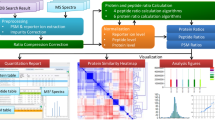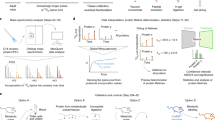Abstract
Absolute quantification in proteomics usually involves simultaneous determination of representative proteolytic peptides and stable isotope–labeled analogs. The principal limitation to widespread implementation of this approach is the availability of standard signature peptides in accurately known amounts. We report the successful design and construction of an artificial gene encoding a concatenation of tryptic peptides (QCAT protein) from several chick (Gallus gallus) skeletal muscle proteins and features for quantification and purification.
This is a preview of subscription content, access via your institution
Access options
Subscribe to this journal
Receive 12 print issues and online access
$259.00 per year
only $21.58 per issue
Buy this article
- Purchase on Springer Link
- Instant access to full article PDF
Prices may be subject to local taxes which are calculated during checkout


Similar content being viewed by others
References
Righetti, P.G., Campostrini, N., Pascali, J., Hamdan, M. & Astner, H. Eur. J. Mass Spectrom. (Chichester, Eng.) 10, 335–348 (2004).
Gerber, S.A., Rush, J., Stemman, O., Kirschner, M.W. & Gygi, S.P. Proc. Natl. Acad. Sci. USA 100, 6940–6945 (2003).
Pan, S. et al. Mol. Cell. Proteomics 4, 182–190 (2005).
Pratt, J.M. et al. Mol. Cell. Proteomics 1, 579–591 (2002).
Doherty, M.K. et al. Proteomics 4, 2082–2093 (2004).
Doherty, M.K., Whitehead, C., McCormack, H., Gaskell, S.J. & Beynon, R.J. Proteomics 5, 522–533 (2005).
Brancia, F.L. et al. Electrophoresis 22, 552–559 (2001).
Acknowledgements
This work was supported by Biotechnology and Biological Sciences Research Council grants to R.J.B. and S.J.G. We are grateful to M. Fischer, Entelechon for his advice. We are grateful to B. Callen for assistance with expression of the QCAT.
Author information
Authors and Affiliations
Corresponding author
Ethics declarations
Competing interests
The QCAT concept has been submitted for patent protection by Entelechon and three of the authors (RJB, SJG and JMP) are cited as inventors.
Supplementary information
Supplementary Figure 1
The DNA sequence, translated protein sequence and features of the QCAT. (PDF 639 kb)
Rights and permissions
About this article
Cite this article
Beynon, R., Doherty, M., Pratt, J. et al. Multiplexed absolute quantification in proteomics using artificial QCAT proteins of concatenated signature peptides. Nat Methods 2, 587–589 (2005). https://doi.org/10.1038/nmeth774
Received:
Accepted:
Published:
Issue Date:
DOI: https://doi.org/10.1038/nmeth774
This article is cited by
-
Construction of à la carte QconCAT protein standards for multiplexed quantification of user-specified target proteins
BMC Biology (2021)
-
Increased carvone production in Escherichia coli by balancing limonene conversion enzyme expression via targeted quantification concatamer proteome analysis
Scientific Reports (2021)
-
Genetic architecture underlying the expression of eight α-amylase trypsin inhibitors
Theoretical and Applied Genetics (2021)
-
A novel mass spectrometry method for the absolute quantification of several cytochrome P450 and uridine 5′-diphospho-glucuronosyltransferase enzymes in the human liver
Analytical and Bioanalytical Chemistry (2020)
-
Quantitative assay of targeted proteome in tomato trichome glandular cells using a large-scale selected reaction monitoring strategy
Plant Methods (2019)



